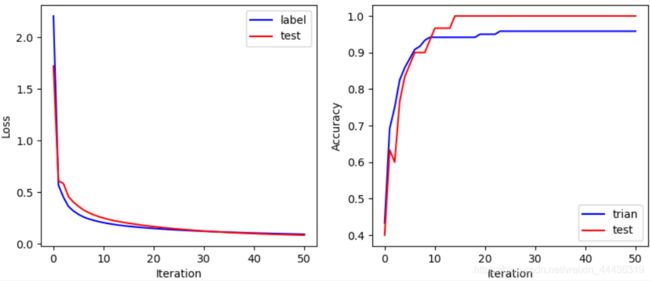人工神经网络
神经元与感知器
M-P神经元


M-P神经元的权值向量W无法自动学习和更新,不具备学习的能力
感知机
- 自动调整权值,具备学习能力
- 第一个用算法来精确定义的神经网络模型
- 线性二分类的分类器
- 感知机算法存在多个解,受到权值向量初始值,错误样本顺序的影响对于非线性可分的数据集,感知机训练法则无法收敛。
Delta法则:使用梯度下降法,找到能够最佳拟合训练样本集的权向量。
逻辑回归可以看做单层神经网络
神经网络的设计:
- 神经网络的结构
- 激活函数
- 损失函数
鸢尾花实例
(单层神经网络)
import tensorflow as tf
import pandas as pd
import numpy as np
import matplotlib as mpl
import matplotlib.pyplot as plt
#设置GPU的使用模式,避免GPU显存空间不足
# gpus=tf.config.experimental.list_physical_devices('GPU')
# tf.config.experimental.set_memory_growth(gpus[0],True)
#加载数据
TRAIN_URL = "http://download.tensorflow.org/data/iris_training.csv"
train_path = tf.keras.utils.get_file(TRAIN_URL.split("/")[-1],TRAIN_URL)
TEST_URL = "http://download.tensorflow.org/data/iris_test.csv"
test_path = tf.keras.utils.get_file(TEST_URL.split('/')[-1],TEST_URL)
df_iris_train = pd.read_csv(train_path,header=0)
df_iris_test = pd.read_csv(test_path,header=0)
iris_train = np.array(df_iris_train)
iris_test = np.array(df_iris_test)
print(iris_train.shape, iris_test.shape)
#数据处理
x_train = iris_train[:,0:4]#属性值
y_train = iris_train[:,4]#标签值
x_test = iris_test[:,0:4]
y_test = iris_test[:,4]
print(x_train.shape,y_train.shape)
print(x_test.shape,y_test.shape)
#对属性值进行标准化处理
x_train = x_train-np.mean(x_train,axis=0)
x_test = x_test-np.mean(x_test,axis=0)
print(x_train.dtype,y_train.dtype)
X_train = tf.cast(x_train,tf.float32)
Y_train = tf.one_hot(tf.constant(y_train,dtype=tf.int32),3)
X_test = tf.cast(x_test,tf.float32)
Y_test = tf.one_hot(tf.constant(y_test,dtype=tf.int32),3)
print(X_train.shape,Y_train.shape)
print(X_test.shape,Y_test.shape)
#设置超参数和现实间隔
learn_rate = 0.5
iter = 50
display_step = 10
#设置模型参数初始值
np.random.seed(612)
W=tf.Variable(np.random.randn(4,3),dtype=tf.float32)#权重为4行3列的二维张量
B = tf.Variable(np.zeros([3]),dtype=tf.float32)#偏置值为一维张量
acc_train = []
acc_test = []
cce_trian = []
cce_test = []
#训练模型
for i in range(0,iter+1):
with tf.GradientTape() as tape:
PRED_train = tf.nn.softmax(tf.matmul(X_train,W)+B)
Loss_train = tf.reduce_mean(tf.keras.losses.categorical_crossentropy(y_true=Y_train,y_pred=PRED_train))
PRED_test = tf.nn.softmax(tf.matmul(X_test,W)+B)
Loss_test = tf.reduce_mean(tf.keras.losses.categorical_crossentropy(y_true=Y_test,y_pred=PRED_test))
accuracy_train = tf.reduce_mean(tf.cast(tf.equal(tf.argmax(PRED_train.numpy(),axis=1),y_train),tf.float32))
accuracy_test = tf.reduce_mean(tf.cast(tf.equal(tf.argmax(PRED_test.numpy(),axis=1),y_test),tf.float32))
acc_train.append(accuracy_train)
acc_test.append(accuracy_test)
cce_trian.append(Loss_train)
cce_test.append(Loss_test)
grads = tape.gradient(Loss_train,[W,B])
W.assign_sub(learn_rate*grads[0])
B.assign_sub(learn_rate*grads[1])
if i % display_step == 0:
print("i: %i, TrainAcc:%f, TrainLoss:%f, TestAcc:%f, TestLoss: %f"%(i,accuracy_train,Loss_train,accuracy_test,Loss_test))
#结果可视化
plt.figure(figsize=(10,4))
plt.subplot(121)
plt.plot(cce_trian,color="blue",label="label")
plt.plot(cce_test,color = "red",label="test")
plt.xlabel("Iteration")
plt.ylabel("Loss")
plt.legend()
plt.subplot(122)
plt.plot(acc_train,color = "blue",label = "trian")
plt.plot(acc_test,color = "red",label = "test")
plt.xlabel("Iteration")
plt.ylabel("Accuracy")
plt.legend()
plt.show()
import tensorflow as tf
import pandas as pd
import numpy as np
import matplotlib.pyplot as plt
#设置GPU的使用模式,避免GPU显存空间不足
# gpus=tf.config.experimental.list_physical_devices('GPU')
# tf.config.experimental.set_memory_growth(gpus[0],True)
#加载数据
TRAIN_URL = "http://download.tensorflow.org/data/iris_training.csv"
train_path = tf.keras.utils.get_file(TRAIN_URL.split("/")[-1],TRAIN_URL)
TEST_URL = "http://download.tensorflow.org/data/iris_test.csv"
test_path = tf.keras.utils.get_file(TEST_URL.split('/')[-1],TEST_URL)
df_iris_train = pd.read_csv(train_path,header=0)
df_iris_test = pd.read_csv(test_path,header=0)
iris_train = np.array(df_iris_train)
iris_test = np.array(df_iris_test)
print(iris_train.shape, iris_test.shape)
#数据处理
x_train = iris_train[:,0:4]#属性值
y_train = iris_train[:,4]#标签值
x_test = iris_test[:,0:4]
y_test = iris_test[:,4]
print(x_train.shape,y_train.shape)
print(x_test.shape,y_test.shape)
#对属性值进行标准化处理
x_train = x_train-np.mean(x_train,axis=0)
x_test = x_test-np.mean(x_test,axis=0)
print(x_train.dtype,y_train.dtype)
X_train = tf.cast(x_train,tf.float32)
Y_train = tf.one_hot(tf.constant(y_train,dtype=tf.int32),3)
X_test = tf.cast(x_test,tf.float32)
Y_test = tf.one_hot(tf.constant(y_test,dtype=tf.int32),3)
print(X_train.shape,Y_train.shape)
print(X_test.shape,Y_test.shape)
#设置超参数和现实间隔
learn_rate = 0.5
iter = 50
display_step = 10
#设置模型参数初始值
np.random.seed(612)
W1=tf.Variable(np.random.randn(4,16),dtype=tf.float32)#权重为4行3列的二维张量
B1 = tf.Variable(tf.zeros([16]),dtype=tf.float32)#偏置值为一维张量
W2 = tf.Variable(np.random.randn(16,3),dtype=tf.float32)
B2 = tf.Variable(tf.zeros([3]),dtype=tf.float32)
acc_train = []
acc_test = []
cce_trian = []
cce_test = []
#训练模型
for i in range(0,iter+1):
with tf.GradientTape() as tape:
Hidden_train = tf.nn.relu(tf.matmul(X_train,W1)+B1)
PRED_train = tf.nn.softmax(tf.matmul(Hidden_train,W2)+B2)
Loss_train = tf.reduce_mean(tf.keras.losses.categorical_crossentropy(y_true=Y_train,y_pred=PRED_train))
HIdden_test = tf.nn.relu(tf.matmul(X_test,W1)+B1)
PRED_test = tf.nn.softmax(tf.matmul(HIdden_test,W2)+B2)
Loss_test = tf.reduce_mean(tf.keras.losses.categorical_crossentropy(y_true=Y_test,y_pred=PRED_test))
accuracy_train = tf.reduce_mean(tf.cast(tf.equal(tf.argmax(PRED_train.numpy(),axis=1),y_train),tf.float32))
accuracy_test = tf.reduce_mean(tf.cast(tf.equal(tf.argmax(PRED_test.numpy(),axis=1),y_test),tf.float32))
acc_train.append(accuracy_train)
acc_test.append(accuracy_test)
cce_trian.append(Loss_train)
cce_test.append(Loss_test)
grads = tape.gradient(Loss_train,[W1,B1,W2,B2])
W1.assign_sub(learn_rate*grads[0])
B1.assign_sub(learn_rate*grads[1])
W2.assign_sub(learn_rate*grads[2])
B2.assign_sub(learn_rate*grads[3])
if i % display_step == 0:
print("i: %i, TrainAcc:%f, TrainLoss:%f, TestAcc:%f, TestLoss: %f"%(i,accuracy_train,Loss_train,accuracy_test,Loss_test))
#结果可视化
plt.figure(figsize=(10,4))
plt.subplot(121)
plt.plot(cce_trian,color="blue",label="label")
plt.plot(cce_test,color = "red",label="test")
plt.xlabel("Iteration")
plt.ylabel("Loss")
plt.legend()
plt.subplot(122)
plt.plot(acc_train,color = "blue",label = "trian")
plt.plot(acc_test,color = "red",label = "test")
plt.xlabel("Iteration")
plt.ylabel("Accuracy")
plt.legend()
plt.show()
理论上,如果神经网络中有足够的隐含层,每个隐含层中有足够多的神经元,神经网络就可以表示任意复杂的函数或空间分布。
误差反向传播算法(Backpropagation,BP)
利用链式法则,反向传播损失函数的梯度信息,计算出损失函数对网络中所有模型参数的梯度。
- 只有一组输入和一组输出
- 各个层按照先后顺序堆叠
Sequential模型实现手写数字识别实例
import tensorflow as tf
import numpy as np
import matplotlib.pyplot as plt
#设置GPU的使用模式,避免GPU显存空间不足
# gpus=tf.config.experimental.list_physical_devices('GPU')
# tf.config.experimental.set_memory_growth(gpus[0],True)
#下载mnist数据集
# mnist = tf.keras.datasets.mnist
# (train_x, train_y),(test_x,test_y) = mnist.load_data()
#提前下载好数据集自行读取
mnist = np.load('mnist.npz')
train_x = mnist['x_train']
train_y = mnist['y_train']
test_x = mnist['x_test']
test_y = mnist['y_test']
print(train_x.shape)
print(train_y.shape)
print(test_x.shape)
print(test_y.shape)
#数据预处理
# X_train = train_x.reshape((60000,28*28))
# X_test = test_x.reshape((10000,28*28))
# print(X_train.shape)
# print(X_test.shape)
#对属性进行归一化,使其取值范围在0~1
X_train, X_test = tf.cast(train_x/255.0,tf.float32),tf.cast(test_x/255.0,tf.float32)
y_train,y_test = tf.cast(train_y,tf.int16),tf.cast(test_y,tf.int16)
print(type(X_train),type(y_train))
#建立模型
model = tf.keras.Sequential()
model.add(tf.keras.layers.Flatten(input_shape=(28,28)))#完成形状转换,把输入的属性拉直变成一维数组
model.add(tf.keras.layers.Dense(128,activation='relu'))#添加隐含层,有128个节点,激活函数为relu,该层为全连接层
model.add(tf.keras.layers.Dense(10,activation='softmax'))#添加输出层,有10个节点,激活函数是softmax函数,该层也是全连接层
print(model.summary())#查看网络结果
#配置训练方法
model.compile(optimizer='adam',
loss='sparse_categorical_crossentropy',
metrics=['sparse_categorical_accuracy'])#优化器使用adam,损失函数使用稀疏交叉熵损失函数,准确率使用稀疏分类准确率函数
#训练模型
#划分十分之二的数据为测试集,每个小批量使用64条数据,一共训练5轮
model.fit(X_train,y_train,batch_size=64,epochs=5,validation_split=0.2)
#评估模型
model.evaluate(X_test,y_test,verbose=2)
#使用模型
# 测试集中的前四个数据识别
# model.predict([[X_test[0]]])
# np.argmax(model.predict([X_test[0]]))
# model.predict(X_test[0:4])
y_pred = np.argmax(model.predict(X_test[0:4]),axis=1)
for i in range(4):
plt.subplot(1,4,i+1)
plt.axis('off')
plt.imshow(test_x[i],cmap='gray')
plt.title('y='+str(test_y[i])+'\ny_pred='+str(y_pred[i]))
plt.figure()
#随机从测试集中抽取四个样本来验证
num = np.random.randint(1,10000)
y_pred = np.argmax(model.predict(X_test[num:num+4]),axis=1)
print(y_pred)
for i in range(4):
plt.subplot(1,4,i+1)
plt.axis('off')
plt.imshow(test_x[num],cmap='gray')
plt.title('y='+str(test_y[num])+'\ny_pred='+str(y_pred[i]))
num = num + 1
plt.show()
保存模型
import tensorflow as tf
import numpy as np
import matplotlib.pyplot as plt
#提前下载好数据集自行读取
mnist = np.load('mnist.npz')
train_x = mnist['x_train']
train_y = mnist['y_train']
test_x = mnist['x_test']
test_y = mnist['y_test']
print(train_x.shape)
print(train_y.shape)
print(test_x.shape)
print(test_y.shape)
#数据预处理
#对属性进行归一化,使其取值范围在0~1
X_train, X_test = tf.cast(train_x/255.0,tf.float32),tf.cast(test_x/255.0,tf.float32)
y_train,y_test = tf.cast(train_y,tf.int16),tf.cast(test_y,tf.int16)
print(type(X_train),type(y_train))
#建立模型
model = tf.keras.Sequential()
model.add(tf.keras.layers.Flatten(input_shape=(28,28)))#完成形状转换,把输入的属性拉直变成一维数组
model.add(tf.keras.layers.Dense(128,activation='relu'))#添加隐含层,有128个节点,激活函数为relu,该层为全连接层
model.add(tf.keras.layers.Dense(10,activation='softmax'))#添加输出层,有10个节点,激活函数是softmax函数,该层也是全连接层
print(model.summary())#查看网络结果
#配置训练方法
model.compile(optimizer='adam',
loss='sparse_categorical_crossentropy',
metrics=['sparse_categorical_accuracy'])#优化器使用adam,损失函数使用稀疏交叉熵损失函数,准确率使用稀疏分类准确率函数
#训练模型
#划分十分之二的数据为测试集,每个小批量使用64条数据,一共训练5轮
model.fit(X_train,y_train,batch_size=64,epochs=5,validation_split=0.2)
#评估模型
model.evaluate(X_test,y_test,verbose=2)
#保存模型
model.save('mnist_model.h5')#保存完整模型到h5网页
读取保存的模型
import tensorflow as tf
import numpy as np
import matplotlib.pyplot as plt
#提前下载好数据集自行读取
mnist = np.load('mnist.npz')
train_x = mnist['x_train']
train_y = mnist['y_train']
test_x = mnist['x_test']
test_y = mnist['y_test']
print(train_x.shape)
print(train_y.shape)
print(test_x.shape)
print(test_y.shape)
#数据预处理
#对属性进行归一化,使其取值范围在0~1
X_train, X_test = tf.cast(train_x/255.0,tf.float32),tf.cast(test_x/255.0,tf.float32)
y_train,y_test = tf.cast(train_y,tf.int16),tf.cast(test_y,tf.int16)
print(type(X_train),type(y_train))
#读取保存的模型
model = tf.keras.models.load_model('mnist_model.h5')
model.summary()
#评估模型
model.evaluate(X_test,y_test,verbose=2)
#随机从测试集中抽取四个样本来验证
num = np.random.randint(1,10000)
y_pred = np.argmax(model.predict(X_test[num:num+4]),axis=1)
print(y_pred)
for i in range(4):
plt.subplot(1,4,i+1)
plt.axis('off')
plt.imshow(test_x[num],cmap='gray')
plt.title('y='+str(test_y[num])+'\ny_pred='+str(y_pred[i]))
num = num + 1
plt.show()





